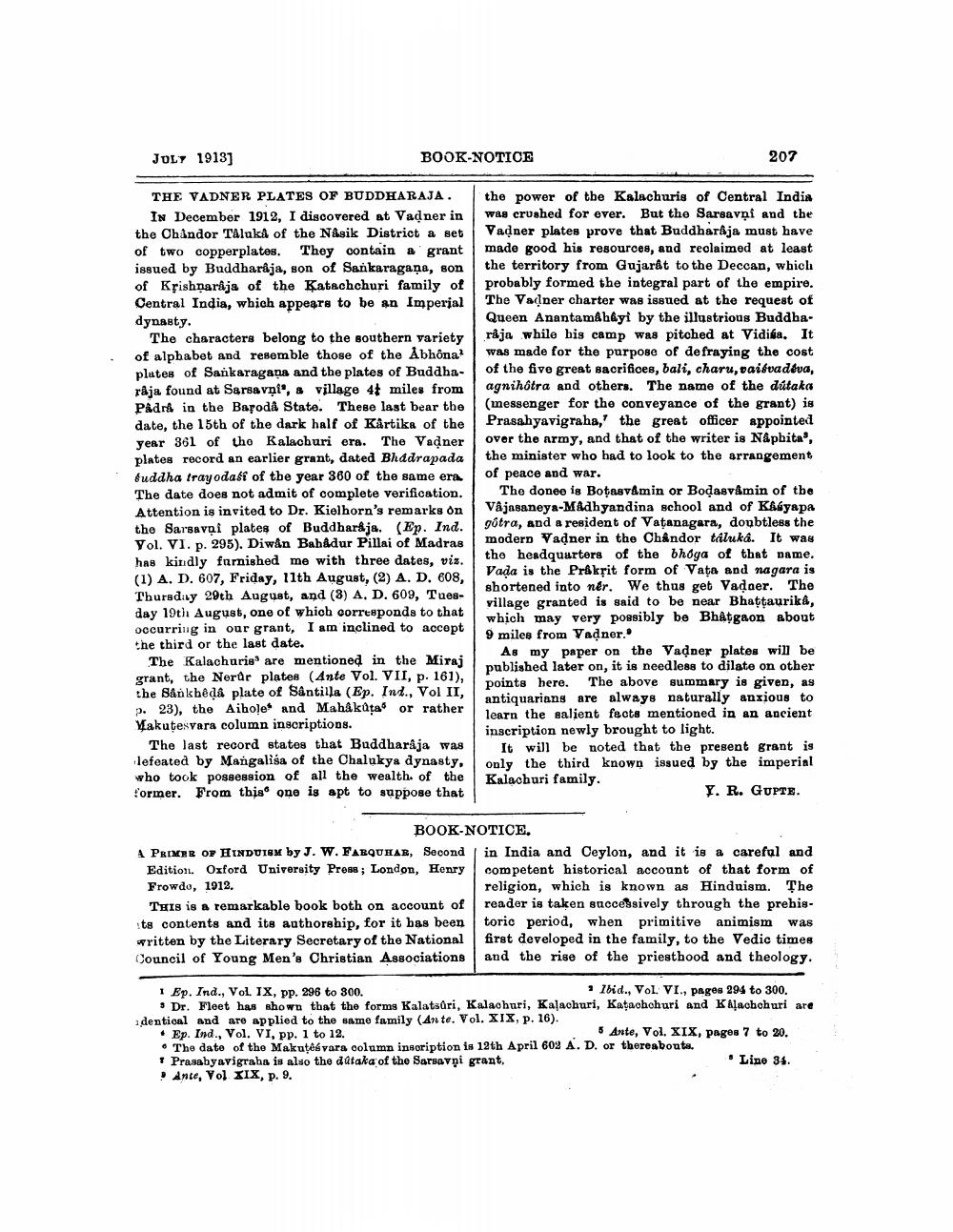________________
BOOK-NOTICE
JULY 1913]
THE VADNER PLATES OF BUDDHARAJA. IN December 1912, I discovered at Vaḍner in the Chandor Taluk of the Nasik District a set of two copperplates. They contain a grant issued by Buddharaja, son of Sankaragana, son of Krishnaraja of the Katachchuri family of Central India, which appears to be an Imperial dynasty.
The characters belong to the southern variety of alphabet and resemble those of the Abhôna' plates of Sankaragana and the plates of Buddharaja found at Sarsavņi", a village 4 miles from Pâdra in the Barodâ State. These last bear the date, the 15th of the dark half of Kartika of the year 361 of the Kalachuri era. The Vadner plates record an earlier grant, dated Bhadrapada buddha trayodasf of the year 360 of the same era. The date does not admit of complete verification. Attention is invited to Dr. Kielhorn's remarks on the Sarsavai plates of Buddharaja. (Ep. Ind. Vol. VI. p. 295). Diwan Bahadur Pillai of Madras has kindly furnished me with three dates, viz. (1) A. D. 607, Friday, 11th August, (2) A. D. 608, Thursday 29th August, and (3) A. D. 609, Tuesday 19th August, one of which corresponds to that occurring in our grant, I am inclined to accept the third or the last date.
The Kalachuris are mentioned in the Miraj grant, the Nerûr plates (4nte Vol. VII, p. 161), the Sankheda plate of Sântilla (Ep. Ind., Vol II, p. 23), the Aihole and Mahâkúta or rather Makutesvara column inscriptions.
The last record states that Buddharaja was lefeated by Mangalisa of the Chalukya dynasty, who took possession of all the wealth of the former. From this one is apt to suppose that
A PRIMER OF HINDUISM by J. W. FARQUHAR, Second Edition. Oxford University Press; London, Henry Frowdo, 1912.
THIS is a remarkable book both on account of its contents and its authorship, for it has been written by the Literary Secretary of the National Council of Young Men's Christian Associations
the power of the Kalachuris of Central India was crushed for ever. But the Sarsavņi and the Vadner plates prove that Buddharaja must have made good his resources, and reclaimed at least the territory from Gujarât to the Deccan, which probably formed the integral part of the empire. The Vadner charter was issued at the request of Queen Anantamâhâyi by the illustrious Buddharaja while his camp was pitched at Vidiúa. It was made for the purpose of defraying the cost of the five great sacrifices, bali, charu, vaiévadéva, agnihotra and others. The name of the dútaka (messenger for the conveyance of the grant) is Prasahyavigraha,' the great officer appointed over the army, and that of the writer is Nâphita3, the minister who had to look to the arrangement of peace and war.
207
The donee is Botasvamin or Bodasvâmin of the Vâjasaneya-Madhyandina school and of Kasyapa gútra, and a resident of Vatanagara, doubtless the modern Vadner in the Chândor talukâ. It was the headquarters of the bhoga of that name. Vada is the Prakrit form of Vata and nagara is shortened into ner. We thus get Vadaer. The village granted is said to be near Bhaṭṭaurik&, which may very possibly be Bhatgaon about 9 miles from Vaḍner.
BOOK-NOTICE.
As my paper on the Vadner plates will be published later on, it is needless to dilate on other points here. The above summary is given, as antiquarians are always naturally anxious to learn the salient facts mentioned in an ancient inscription newly brought to light.
It will be noted that the present grant is only the third known issued by the imperial Kalachuri family.
Y. R. GUPTE.
in India and Ceylon, and it is a careful and competent historical account of that form of religion, which is known as Hinduism. The reader is taken successively through the prehistoric period, when primitive animism was first developed in the family, to the Vedic times and the rise of the priesthood and theology.
1 Ep. Ind., Vol. IX, pp. 296 to 300.
Ibid., Vol. VI., pages 294 to 300.
Dr. Fleet has shown that the forms Kalatsûri, Kalachuri, Kalachuri, Kaṭachchuri and Kalachchuri are identical and are applied to the same family (Ante. Vol. XIX, p. 16).
Ep. Ind., Vol. VI, pp. 1 to 12.
The date of the Makutéévara column inscription is 12th April 602 A. D. or thereabouts. Prasabyavigraha is also the dûtaka of the Sarsavņi grant, Ante, Vol XIX, p. 9.
5 Ante, Vol. XIX, pages 7 to 20.
Line 34.




